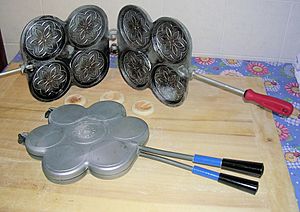Crescentina modenese facts for kids

A dish of crescentinas
|
|
| Type | Bread |
|---|---|
| Course | Entrée |
| Place of origin | Italy |
Crescentine, also known as crescente or tigelle, are small, round, thin breads from the Apennines mountains in the Modena area of Northern Italy. They are about 10 centimeters (4 inches) wide. These tasty breads are made from simple ingredients like flour, water, salt, and yeast.
Traditionally, crescentine are eaten filled with cunza, a special spread made from pork fat flavored with garlic and rosemary. They can also be filled with cold meats, wild boar, rabbit, cheese, or even sweet spreads like jam. While they have been a favorite in homes and traditional restaurants for a long time, you can now find them in some fast-food and casual restaurants too! Other similar breads made in nearby areas include piadina, borlengo, gnocco fritto, and panigaccio.
How Crescentine Got Their Name
Originally, these breads were baked between special clay tiles called tigelle. The word tigella comes from a Latin word that means "cover." Over time, people started calling the bread itself tigella instead of just the baking tile.
Today, crescentine are often baked in restaurants using electric griddles. If you want to make them at home, you would use a special aluminum pan called a tigelliera or cottola. This pan is placed over a gas stove.
A Traditional Italian Food
Crescentine are so important to Italian food culture that the Italian Ministry of Agriculture has officially recognized them as a Traditional Agribusiness Product. This means they are a special part of Italy's food heritage.
See also
 In Spanish: Crescentina para niños
In Spanish: Crescentina para niños


